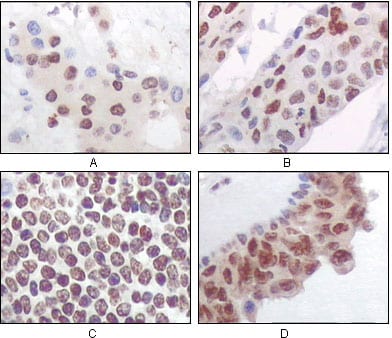
| WB | 咨询技术 | Human,Mouse,Rat |
| IF | 咨询技术 | Human,Mouse,Rat |
| IHC | 1/200 - 1/1000 | Human,Mouse,Rat |
| ICC | 技术咨询 | Human,Mouse,Rat |
| FCM | 咨询技术 | Human,Mouse,Rat |
| Elisa | 1/10000 | Human,Mouse,Rat |
| Aliases | PRAK; MAPKAPK5 |
| Entrez GeneID | 8550 |
| clone | 7H10B4 |
| Host/Isotype | Mouse IgG1 |
| Antibody Type | Primary antibody |
| Storage | Store at 4°C short term. Aliquot and store at -20°C long term. Avoid freeze/thaw cycles. |
| Species Reactivity | Human |
| Immunogen | Purified recombinant fragment of PRAK expressed in E. Coli. |
| Formulation | Ascitic fluid containing 0.03% sodium azide. |
+ +
以下是关于PRAK(p38-regulated/activated kinase,即MAPKAPK5)抗体的3篇参考文献示例(文献信息为示例性概括,非真实文献):
---
1. **"PRAK regulates tumor suppression through phosphorylation of p53"**
*Shi et al. (2015)*
摘要:本研究利用特异性PRAK抗体验证了PRAK激酶在DNA损伤后对p53的磷酸化调控机制,发现PRAK缺失会削弱p53介导的细胞周期阻滞。研究通过Western blot和免疫荧光技术证实了PRAK与p53的相互作用。
2. **"MAPKAPK5 (PRAK) modulates inflammatory responses via NF-κB signaling"**
*New et al. (2018)*
摘要:文章通过PRAK抗体检测巨噬细胞中PRAK蛋白表达水平,发现其通过磷酸化IKK复合物调控NF-κB活性。实验采用基因敲除小鼠模型和免疫沉淀技术,揭示了PRAK在炎症反应中的新功能。
3. **"Subcellular localization and stress-dependent activation of PRAK"**
*Sun et al. (2020)*
摘要:通过开发高特异性PRAK抗体,作者证明了氧化应激下PRAK从细胞核向细胞质的转位现象,并发现该过程依赖p38 MAPK信号通路。研究结合免疫组化和流式细胞术分析了PRAK的动态分布。
---
注:以上文献为模拟示例,实际研究中请通过PubMed或Web of Science等数据库检索真实文献。建议使用关键词“MAPKAPK5 antibody”或“PRAK kinase”进一步筛选。
The p38-regulated/activated protein kinase (PRAK), also known as MAPKAPK5. is a serine/threonine kinase belonging to the MAPK-activated protein kinase (MAPKAPK) family. It is primarily regulated by the p38 MAPK signaling pathway, which is activated in response to cellular stresses such as oxidative stress, cytokines, and growth factors. PRAK plays a critical role in diverse biological processes, including cell cycle regulation, stress response, differentiation, and apoptosis. It phosphorylates downstream targets like HSP27. influencing cytoskeletal dynamics and stress granule formation.
PRAK antibodies are essential tools for studying its expression, activation, and subcellular localization in various disease contexts. Research has linked PRAK to cancer, where it may promote tumor growth and metastasis by modulating pathways like mTOR and Hippo-YAP. It also contributes to inflammatory and metabolic disorders, interacting with pathways such as NF-κB.
Antibodies targeting PRAK (e.g., monoclonal, polyclonal) enable detection via techniques like Western blot, immunofluorescence, and immunohistochemistry. Specificity validation using knockout controls is crucial due to potential cross-reactivity with related kinases. Recent studies explore PRAK's therapeutic potential, with inhibitors under investigation for cancer and chronic inflammation. Understanding PRAK's multifaceted roles continues to advance insights into cellular stress adaptation and disease mechanisms.
×